Python (missile)
The Rafael Python is a family of air-to-air missiles (AAMs) built by the Israeli weapons manufacturer Rafael Advanced Defense Systems, formerly RAFAEL Armament Development Authority. Originally starting with the Shafrir (Hebrew: שפריר, loosely translated as Dragonfly, a male form of inflection for Damselfly (שפרירית)) series, the Shafrir-1 missile was developed in 1959, followed by the Shafrir-2 in early 1970s. Subsequently, the missiles were given the western name of "Python" by the parent company for export purposes, starting with the Python-3 in 1978. Since then, it has been further developed and evolved into the Python-4, Python-5, Derby and also, the SPYDER, an advanced ground-based air-defence system. Currently, the missiles are in service with the armed forces of over fifteen countries from around the world.
| Rafael Python | |
|---|---|
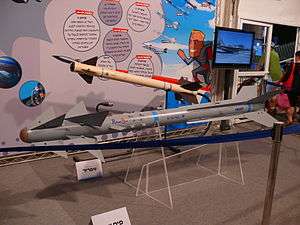 The newest and the oldest member of the Python family of AAM for comparisons, Python-5 (displayed lower-front) and Shafrir-1 (upper-back). | |
| Type | Short-range air-to-air missile |
| Place of origin | Israel |
| Service history | |
| Used by | See operators |
| Production history | |
| Manufacturer | Rafael Advanced Defense Systems |
| Unit cost | Shafrir series: Shafrir-1: US$20,000 |
| Produced |
|
| Specifications | |
| Mass | 103.6 kilograms (228 pounds 6 ounces) |
| Length | 3.1 metres (10 feet) |
| Diameter | 160 millimetres (6.3 inches) |
| Warhead | 11 kg (24 lb 4 oz) |
Detonation mechanism | proximity |
| Engine | solid fuel rocket motor |
| Wingspan | 640 mm (25 in) |
Operational range | >20 kilometres (12 miles) |
| Flight altitude | N/A |
| Maximum speed | Mach 4 |
Guidance system | infrared homing + 320×240 pixel dual waveband electro-optical imaging seeker, lock on after launch, with infrared counter-counter-measures (IRCCM) |
Launch platform | Aircraft:
CASA C-101 Aviojet F-4E Kurnass 2000 F-5E/F Tiger-II McDonnell Douglas F-15 Eagle General Dynamics F-16 Fighting Falcon[1] Dassault Mirage III Dassault Mirage 5 Dassault Mirage 2000 IAI Nesher/Dagger/Finger IAI Kfir BAE Sea Harrier HAL Tejas SAAB Gripen NG[2] Sukhoi Su-30MKI Su-25KM Scorpion[3] |
Design and development
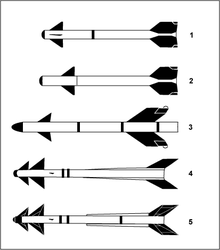
In the 1950s, the Israeli Air Force (IAF) submitted requirements for a domestically-made air-to-air missile, to promote domestic defense industry and reduce reliance on imports. Rafael Armament Development Authority was contracted to develop the Shafrir (Hebrew: שפריר, loosely translated as Dragonfly, a male form of inflection for Damselfly (שפרירית)) in 1959. The missile entered operational status with Israeli Mirage jets in 1963, but the IAF was unhappy with its performance and no air combat kills were achieved with it during the Six-Day War, kills being made with guns instead. The improved Shafrir-2 was soon introduced in 1971, and it proved to be one of the most successful air-to-air missiles ever made. During the 1973 Yom Kippur War, the IAF launched 176 Shafrir-2 missiles, destroying 89 enemy aircraft.[4] The Shafrir-2 was exported along with Israeli-made aircraft to South American countries.
After the Shafrir-2, the new missiles made by Rafael were given the western name of Python. This is why the next missile built by Rafael in early 1970s was named Python-3, but there is no Python-1 or Python-2 (they were Shafrir-1, Shafrir-2). The Python-3 has improved range and all-aspect attack ability, it proved itself before and during the 1982 Lebanon War, destroying 35 enemy aircraft. The People's Republic of China was impressed with its performance and license-built the Python-3 as the PiLi-8 (PL-8) AAM.[5]
Further improvements to the Python-3 led to the development of Python-4 in mid-1980s, which had limited "fire-and-forget" ability but added the option for helmet-sight guidance.[6] In the 1990s Rafael started development on the Python-5 AAM, which was equipped with an advanced electro-optical imaging seeker with lock-on after-launch ability.[7] The new missile was show-cased in 2003 Paris Air Show, and intended for service with IAF the F-15I Ra'am ("Thunder") and the F-16I Sufa ("Storm").
The Python-5 is said to have full sphere launch ability or is an all-aspect missile, meaning it can be launched at a target regardless of the target's location relative to the direction of the launching aircraft. It can lock onto targets after launch, even when they are up to 100 degrees off the boresight of the launching aircraft.
Variants
Shafrir-1
The Shafrir-1 was developed in 1959–1964 to fulfill IAF's requirement for a domestic air-to-air missile. It was intended to build the domestic defense industry's abilities, and reduce reliance on foreign imports. The fear of foreign dependence was later proven when France banned arms export to Israel.
The Shafrir-1 was intended for use on French-built Mirage jets. The first testing took place in France in 1963. However the missile's performance was so poor that they immediately started on the next improved version, the Shafrir-2.[8]
- Length: 250 cm (2.5 m)
- Span: 55 cm
- Diameter: 14 cm
- Weight: 65 kg
- Guidance: IR
- Warhead: 11 kg blast explosive, later 30 kg
- Range: 5 km
- Speed: ??
Shafrir-2
The Shafrir-2 was credited with 89 kills in the 1973 Yom Kippur War.[4] During its whole service life, it is credited with a total of 106 kills.
- Length: 250 cm (2.5 m)
- Span: 55 cm
- Diameter: 15 cm
- Weight: 93 kg
- Guidance: IR
- Warhead: 11 kg
- Range: 5 km
- Speed: ??
Python-3

The Python-3 is a much-improved AAM with all-aspect attack ability, higher speed, range, and performance. It performed well before and during the 1982 Lebanon War, scoring 35 (other sources claim 50) kills.[7]
China's PLAAF was quite impressed with this missile, and paid for licensed production as the PL-8 AAM in the 1980s.[5] The program code named "Number 8 Project" (八号工程) and formally started on September 15, 1983. From March 1988 to April 1989, technology transfer to China was complete while license assembly and license built parts continued, and by the spring of 1989, the complete domestic Chinese built missile received state certification. The major supplier of the missile was Xi'an Eastern Machinery Factory (西安东方机械厂) located at Xi'an, and China is also reported to have developed a helmet-mounted sight (HMS) system for the PL-8.[5]
- Length: 295 cm
- Span: 80 cm
- Diameter: 16 cm
- Weight: 120 kg
- Guidance: IR
- Warhead: 11 kg, active proximity fuse
- Range: 15 km
- Speed: Mach 3.5
Python-4
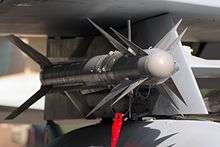
The Python-4 is a 4th generation AAM with all-aspect attack ability, and integration with a helmet-mounted sight (HMS) system.[6] It entered service in the 1990s, and like its predecessor Python-3, it is integrated with the Elbit Systems DASH (Display And Sight Helmet) HMS system for Israeli F-15s and F-16s, Chilean F-16s (MLU and C/D block 50/52 plus), F-5E/F Tiger III, South American Kfirs and the SAAB JAS 39 Gripen. The missile's seeker is reported to use dual band technology array similar to that of US FIM-92 Stinger (infrared homing and ultraviolet), with IRCCM (IR ECCM) ability to reduce background IR radiation to reduce the effectiveness of enemy flares.[9]
- Length: 300 cm
- Span: 50 cm
- Diameter: 16 cm
- Weight: 120 kg
- Guidance: IR
- Warhead: 11 kg, active laser proximity fuse with back-up impact fuse
- Range: 15 km
- Speed: Mach 3.5 or more
Python-5

The Python-5[10] is currently the most capable air-to-air missile in Israel's inventory and one of the most advanced AAMs in the world. As a beyond-visual-range missile, it is capable of "lock-on after launch" (LOAL), and has full-sphere/all-direction (including rearward) attack ability. The missile features an advanced electro-optical infrared homing seeker which scans the target area for hostile aircraft, then locks-on for terminal chase. With a total of eighteen control surfaces and careful design, the resulting missile is supposed to be as maneuverable as any other air-to-air missiles with thrust vectoring nozzles.[7] The Python-5 was first used in combat during the 2006 Lebanon War, when it was used by F-16 Fighting Falcons to destroy two Iranian-made Ababil UAVs used by the Hezbollah.[1]
- Length: 310 cm
- Span: 64 cm
- Diameter: 16 cm
- Weight: 105 kg
- Guidance: IR + electro-optical imaging
- Warhead: 11 kg
- Range: >20 km
- Speed: Mach 4
Other Python developments
Derby

Also known as the Alto, the Derby missile is a BVR, medium-range (~50 km) active radar homing missile. Though technically not part of the "Python" family, the missile is an enlarged version of the Python-4 with an active-radar seeker.[11]
- Length: 362 cm
- Span: 64 cm
- Diameter: 16 cm
- Weight: 118 kg
- Guidance: Active Radar
- Warhead: 23 kg
- Range: 50 km
- Speed: Mach 4
I-Derby ER
In June 2015, Rafael confirmed the existence of the I-Derby-ER, an extended range version of the Derby that increases range to 54 nmi (62 mi; 100 km), after a "Python 6" version based on an air-launched Stunner missile was abandoned. To achieve greater range, a dual-pulse solid rocket motor is added, where the secondary pulse of energy as the missile nears the target extends flight time. It also combines the seeker and fuse into an integrated sensor and fusing system to make room for the new motor.[12]
In May 2019, it was reported that India was planning to arm its Su-30MKI fighters with I-Derby ER missiles to replace its R-77 missiles. Previously, in 2018, it had already been selected for Indian Air Force's HAL Tejas fighter.[13]
SPYDER
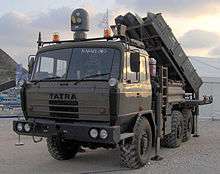
The SPYDER (Surface-to-air PYthon and DERby) is an advanced ground based anti-aircraft missile system developed by Rafael that uses surface-to-air versions of the Python-5 and Derby missiles.
Operators
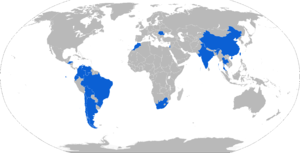
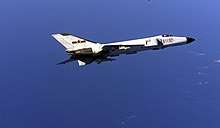
Current operators









.svg.png)









See also
References
- Airframe Details for F-16 #87-1672. F-16.net. Retrieved on 2013-07-17.
- Gripen for Brazil – The Fighter Archived 2013-03-31 at the Wayback Machine. Saabgroup.com. Retrieved on 2013-07-17.
- Fighter SU-25KM (Scorpion). Geo-army.ge (2010-06-28). Retrieved on 2013-07-17.
- Shafrir-2 Archived 2008-09-14 at the Wayback Machine, www.Israeli-Weapons.com.
- "PiLi-8 Short-Range Air-to-Air Missile". SinoDefence.com. 12 October 2008. Archived from the original on 23 January 2012. Retrieved 20 March 2012.
- Python-4 Archived 2006-07-21 at the Wayback Machine, www.Israeli-Weapons.com.
- Python-5 Archived 2006-07-15 at the Wayback Machine, www.Israeli-Weapons.com.
- Shafrir 1 Archived 2008-09-22 at the Wayback Machine, www.Israeli-Weapons.com.
- Carlo Kopp, "Fourth Generation AAMs – The Rafael Python 4" Archived 2006-09-25 at the Wayback Machine, Australian Aviation, April 1997.
- http://www.rafael.co.il/marketing/SIP_STORAGE/FILES/9/1189.pdf Archived 2016-07-29 at the Wayback Machine Python-5 Full Sphere IR Air-to-Air or Surface-to-Air Missile
- Derby Beyond Visual Range Air-to-Air Missile Archived 2006-07-18 at the Wayback Machine, www.Israeli-Weapons.com.
- ISRAEL: Long-range fashion catches on in IAF – Flightglobal.com, 25 January 2015
- Bedi, Rahul (29 May 2019). "IAF plans to arm its Su-30MKI fleet with I-Derby ER BVRAAMs". Jane's Defence Weekly.
- "SIPRI arms transfer database". Stockholm International Peace Research Institute. Information generated on 3 April 2014. Retrieved 3 April 2014. Check date values in:
|date=(help) - International Institute for Strategic Studies (2010). The Military Balance 2010. United Kingdom: Taylor and Francis. p. 66. ISBN 9781857435573.
- International Institute for Strategic Studies (2010). The Military Balance 2010. United Kingdom: Taylor and Francis. p. 72. ISBN 9781857435573.
- International Institute for Strategic Studies (2010). The Military Balance 2010. United Kingdom: Taylor and Francis. p. 82. ISBN 9781857435573.
- "Trade Registers". armstrade.sipri.org.
- http://maxdefense.blogspot.com/2018/12/philippine-air-force-selects-rafael.html. Missing or empty
|title=(help) - International Institute for Strategic Studies (2010). The Military Balance 2010. United Kingdom: Taylor and Francis. p. 158. ISBN 9781857435573.
- "V3S Snake (Rafael Python 3)". South African Air Force. Retrieved 20 March 2012.
External links
| Wikimedia Commons has media related to Python missiles. |
- Python-5 brochure at Rafael's official site
- Derby brochure at Rafael's official site
- Shafrir-1/2 on GlobalSecurity.org
- Python-3/4/5 on GlobalSecurity.org
- Derby on GlobalSecurity.org
- Federation of American Scientists' website on Python-3
- Federation of American Scientists' website on Python-4
- Federation of American Scientists' website on Derby
- Fourth Generation AAMs – The Rafael Python 4